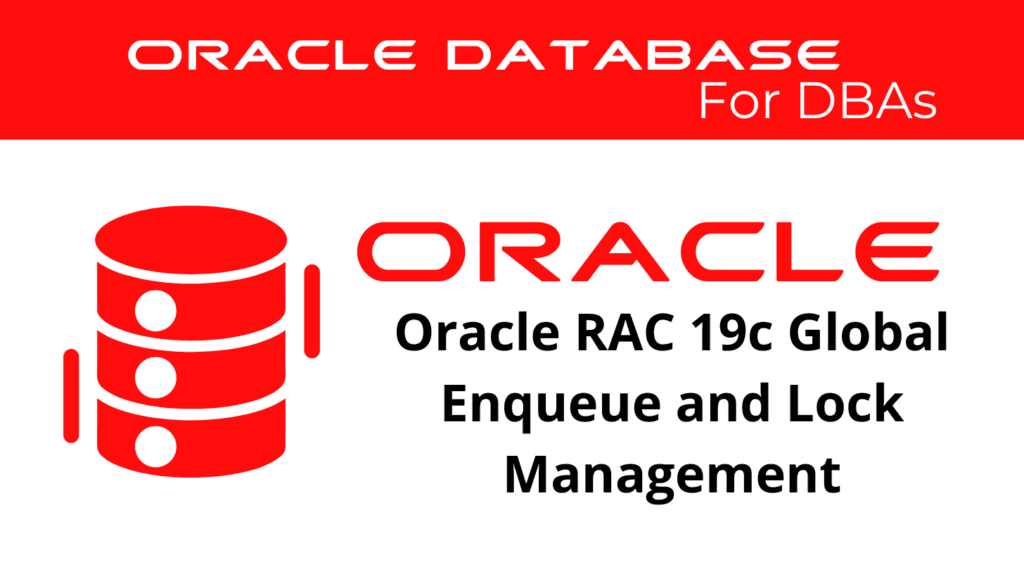
In this article, we will delve into Oracle RAC 19c and how global enqueue and instance lock management are effectively handled. Enqueue management and instance locking are crucial for maintaining data consistency and performance in a clustered environment like Oracle RAC. This tutorial will provide a comprehensive understanding of these concepts within Oracle RAC 19c.
Understanding Enqueue Management
Enqueue management, or queue management, is a critical aspect of Oracle RAC 19c. Efficiently managing enqueues ensures that resources are allocated correctly and that database operations do not conflict with each other. This involves handling various types of locks that coordinate access to shared resources.
Types of Enqueues: Oracle RAC 19c manages several types of enqueues, including TM (DML), TX (Transaction), and ST (Space Management) enqueues. Each type serves a specific purpose in maintaining database consistency and performance.
Example: Viewing Enqueue Statistics:
SELECT * FROM gv$enqueue_statistics;
This query retrieves statistics about enqueue types and their usage across all nodes in the RAC environment.
Tools for Managing Enqueues: Oracle RAC provides several tools for managing enqueues, such as GV$ views and Oracle Enterprise Manager. These tools help administrators monitor and troubleshoot enqueue-related issues, ensuring smooth database operations.
Preparing for Enqueue Management
Before managing enqueues, it is essential to configure the necessary settings and understand the environment.
1. Configuring Init Parameters: Ensure that the initialization parameters related to enqueues are properly configured.
ALTER SYSTEM SET enqueue_resources = 1000 SCOPE = BOTH;
2. Monitoring Enqueue Usage: Regularly monitor enqueue usage to identify potential bottlenecks and conflicts.
Example: Monitoring Enqueue Usage:
SELECT event, total_waits, time_waited FROM gv$system_event WHERE event LIKE 'enq%';
This query provides details about enqueue waits across the RAC system.
📢 You might also like: Oracle RAC 19c Global Buffer Cache Management (Category: RAC and GRID)
Instance Locking Techniques
Instance locking, also known as lock handling, plays a vital role in Oracle RAC 19c. This process involves synchronizing access to shared resources to ensure data integrity and prevent conflicts. Oracle RAC uses a sophisticated lock and Queue management system to handle instance locks efficiently.
Types of Instance Locks: Oracle RAC 19c manages various instance locks, such as DML locks, DDL locks, and internal locks. Each type of lock serves a specific function in controlling access to database objects and resources.
Example: Viewing Lock Information:
SELECT * FROM gv$lock WHERE type IN ('TX', 'TM');
This query retrieves information about transaction and DML locks in the RAC environment.
Managing Instance Locks: Effective lock handling involves monitoring lock usage, identifying lock contention, and resolving conflicts. Tools like Oracle Enterprise Manager and GV$ views aid in this process.
Example: Identifying Lock Contention:
SELECT session_id, blocking_session FROM gv$session WHERE blocking_session IS NOT NULL;
This query identifies sessions that are blocked due to lock contention.
Implementing Enqueue and Instance Lock Management in Oracle RAC
To manage enqueues and instance locks effectively, Oracle RAC 19c utilizes several tools and techniques. These include monitoring enqueue and lock statistics, configuring system parameters, and using Oracle Enterprise Manager for real-time insights.
Step-by-Step Implementation:
- Configuring System Parameters: Adjust system parameters to optimize enqueue and lock handling.
ALTER SYSTEM SET enqueue_resources = 2000 SCOPE = BOTH;
ALTER SYSTEM SET distributed_lock_timeout = 60 SCOPE = BOTH;
- Monitoring Enqueue and Lock Statistics: Regularly monitor system statistics to identify issues and optimize performance.
Ex1: Enqueue Management – Monitoring Enqueue Statistics:
SELECT * FROM gv$enqueue_statistics;
- Using Oracle Enterprise Manager: Utilize Oracle Enterprise Manager for comprehensive monitoring and management.
Ex2: Viewing Locks in OEM: Navigate to the “Performance” tab, then select “Locks” to view detailed information about current locks and potential issues.
- Resolving Lock Contention: Identify and resolve lock contention issues to maintain system performance.
Ex3: Resolving Lock Contention:
SELECT session_id, blocking_session FROM gv$session WHERE blocking_session IS NOT NULL;
Benefits of Effective Enqueue and Instance Lock Management
Effective enqueue and instance lock management, including queue management and lock handling, offers numerous benefits in an Oracle RAC environment. Firstly, it improves overall system performance by preventing resource conflicts and bottlenecks. Secondly, it enhances data consistency and integrity by ensuring proper synchronization of access to shared resources. Lastly, effective management facilitates easier troubleshooting and resolution of issues.
Performance Improvement: Improving performance is one of the main benefits of effective enqueue and instance lock management. By preventing resource conflicts and optimizing lock handling, Oracle RAC 19c ensures smooth and efficient database operations.
Enhanced Stability: Enhanced stability is another key benefit. By managing enqueues and locks effectively, Oracle RAC 19c reduces the risk of system crashes and data corruption, resulting in a more stable and reliable database environment.
Scalability: Scalability is crucial for growing businesses. With effective enqueue and lock management, Oracle RAC 19c can easily scale to handle increased workloads. By ensuring efficient resource allocation and conflict resolution, the system can accommodate more users and higher transaction volumes without compromising performance.
Conclusion
In summary, managing global enqueues and instance locks in Oracle RAC 19c is a complex but essential task. By understanding and implementing effective enqueue management and lock handling techniques, administrators can ensure optimal performance and stability of their Oracle RAC systems. The key to success lies in continuously monitoring, adjusting, and resolving enqueue and lock-related issues to meet the demands of the database system.
See more on Oracle’s website!
Be Oracle RAC and GRID Certified Professional, this world is full of opportunities for qualified DBAs!





